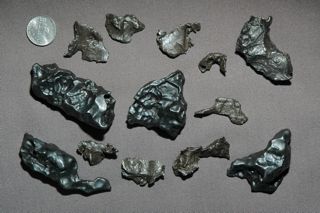Sikhote-Alin meteorite

Fragments from the Sikhote-Alin meteorite shower. Credit: Washington University in St. Louis.
The Sikhote-Alin meteorite is a huge iron meteorite that broke up in the atmosphere and fell as a shower near the village of Paseka in the western part of the Sikhote-Alin mountain range in southeast Siberia at 10:38 am local time on 12 February 1947. Witnesses reported seeing a fireball that was brighter than the Sun. Coming out of the north and descending at an angle of 40°, it left a trail of smoke and dust 30 kilometers long that lingered for several hours. Light and sound from the fall were reported in a radius of some 300 kilometers around the point of impact. Having entered Earth's atmosphere at about 14.5 kikometers per second (31,000 mph), the great iron mass began to break into fragments, which fell together over an elliptical area of about a square kilometer, the biggest making craters and pits, up to 26 meters across and 6 meters deep.
The original mass of the meteorite has been put at more than 70 tons and the largest recovered fragment is a 1,745 kilograms specimen now on display in Moscow. The Sikhote-Alin is classified structurally as a coarsest octahedrite with a Widmanstatten bandwidth of nearly a cm. Chemically it is a Group IIB meteorite, with 5.9% nickel, 0.42% cobalt, 0.46% phosphorus, about 0.28% sulfur, other trace elements, and all the rest iron itself.


